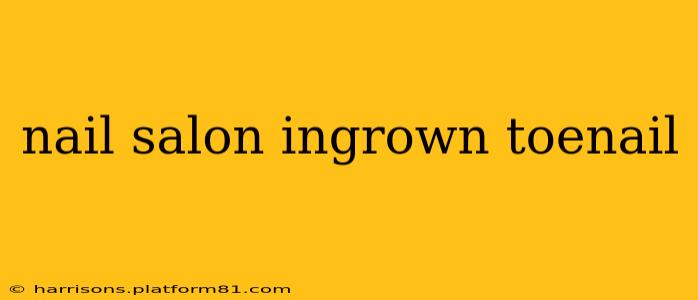Ingrown toenails are a common and painful problem, often leading many to seek professional help from a nail salon. While nail salons can offer some relief and treatment, it's crucial to understand their limitations and when to seek medical attention. This comprehensive guide explores everything you need to know about ingrown toenails and the role nail salons play in their management.
What is an Ingrown Toenail?
An ingrown toenail occurs when the edge of a toenail grows into the surrounding skin. This usually happens at the sides of the nail, most often the big toe. The ingrown portion of the nail can cause pain, redness, swelling, and sometimes infection. The pressure and inflammation can be quite uncomfortable, making walking difficult.
Can a Nail Salon Treat an Ingrown Toenail?
Some nail salons offer ingrown toenail treatments, typically involving trimming and cleaning the affected area. However, nail salons are not medical facilities, and their technicians are not medically trained. While they might provide temporary relief, they cannot diagnose or treat underlying medical conditions that could contribute to ingrown toenails.
What Treatments Do Nail Salons Typically Offer for Ingrown Toenails?
Nail salons may offer the following:
- Nail trimming and shaping: Careful trimming of the nail to relieve pressure on the surrounding skin.
- Cleaning and disinfection: Removing debris and bacteria from the affected area to prevent infection.
- Application of topical treatments: Applying antiseptic creams or ointments to reduce inflammation and promote healing.
It's crucial to understand that these treatments are often temporary solutions and may not address the root cause of the ingrown toenail.
When Should I See a Podiatrist Instead of a Nail Salon?
While nail salons can provide some temporary relief, you should consult a podiatrist (a foot and ankle specialist) if:
- The pain is severe or worsening: Don't try to manage severe pain yourself.
- You have signs of infection: Look for increased redness, swelling, pus, or warmth around the affected toe.
- Home remedies haven't worked: If you've tried soaking and over-the-counter treatments without improvement.
- You have diabetes or other underlying medical conditions: These conditions can increase the risk of complications from ingrown toenails.
- The ingrown toenail recurs frequently: Repeated occurrences suggest an underlying issue requiring professional assessment.
How Can I Prevent Ingrown Toenails?
Prevention is always better than cure! Here are some tips to prevent ingrown toenails:
- Proper nail trimming: Cut your toenails straight across, avoiding rounding the edges.
- Wear properly fitting shoes: Avoid shoes that are too tight or too narrow.
- Keep your feet clean and dry: This helps prevent infection.
- Moisturize your feet regularly: Dry skin can contribute to ingrown toenails.
- Avoid harsh chemicals: Be cautious with harsh chemicals used in some nail salons.
What are the risks of treating an ingrown toenail at a nail salon?
The risks associated with treating an ingrown toenail at a nail salon include:
- Increased risk of infection: Unsanitary conditions can lead to serious infections.
- Improper trimming: Incorrect trimming can worsen the ingrown nail or cause further damage.
- Delayed treatment: Delaying proper medical attention can lead to more severe complications.
- Lack of diagnosis: Nail salon technicians cannot diagnose underlying medical conditions that may be contributing to the problem.
Can a nail salon remove an ingrown toenail?
No, a nail salon should not attempt to remove an ingrown toenail. This is a medical procedure that requires proper training and sterile conditions to avoid infection and further complications. Only a podiatrist or doctor should perform this procedure.
What is the best way to treat an ingrown toenail?
The best way to treat an ingrown toenail depends on the severity of the condition. For mild cases, soaking the foot in warm water and carefully trimming the nail might provide relief. However, for more severe cases, a podiatrist might perform a minor surgical procedure to remove the ingrown portion of the nail or even a partial nail avulsion.
By understanding the limitations of nail salon treatments and seeking appropriate medical care when necessary, you can effectively manage ingrown toenails and prevent future occurrences. Remember, prioritizing your foot health is essential for overall well-being.
